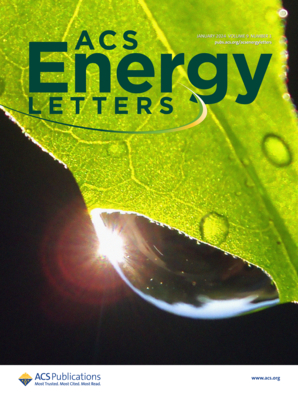通过生物启发离子通道实现超长寿命锰离子电池的锰离子超流态化
IF 18.2
1区 材料科学
Q1 CHEMISTRY, PHYSICAL
引用次数: 0
摘要
可充电水基锌离子电池被认为是一种前景广阔的储能装置。然而,枝晶生长和副反应阻碍了它们的实际应用。本文受生物质膜中酶门控钾通道(KcsA)的超流体和 K+ 离子流的启发,制作了一种接枝了 -ClO4 基团作为功能酶的金属有机框架 (MOF-5),以模拟超流体脂质层结构,用于门控 Zn2+ 的 "开 "和阴离子的 "关 "状态。由于具有完美的 Zn2+/SO42- 选择性(∼10),增强了 Zn2+ 传递数(${t}_{\rm{Z}}{\rm{n}}^{2 + }} = 0.88$)和超流体 Zn2+ 通量(1.9 × 10-3 对比起 KcsA 的 1.67 mmol m-2 s-1)。在 10 mA cm-2/20 mAh cm-2 的条件下,对称电池的寿命超过 5400 小时。具体来说,PMC-Zn//V2O5 袋状电池在 1 A g-1 的条件下循环 2000 次后,仍能保持 81% 的容量。借鉴生物质膜的离子传输调节技术为超长寿命水性电池开辟了一条新途径。本文章由计算机程序翻译,如有差异,请以英文原文为准。
Zn-ion ultrafluidity via bioinspired ion channel for ultralong lifespan Zn-ion battery
Rechargeable aqueous Zn-ion batteries have been deemed as a promising energy storage device. However, the dendrite growth and side reactions have hindered their practical application. Herein, inspired by the ultrafluidic and K+ ion-sieving flux through enzyme-gated potassium channels (KcsA) in biological plasma membranes, a metal-organic-framework (MOF-5) grafted with –ClO4 groups as functional enzymes is fabricated to mimic the ultrafluidic lipid-bilayer structure for gating Zn2+ ‘on’ and anions ‘off’ states. Resulting from the perfect Zn2+/SO42− selectivity (∼10), enhanced Zn2+ transfer number (${t}_{{\rm{Z}}{{\rm{n}}}^{2 + }} = 0.88$) and the ultrafluidic Zn2+ flux (1.9 × 10−3 vs. 1.67 mmol m−2 s−1 for KcsA). The symmetric cells achieve a lifespan of over 5400 h at 10 mA cm−2/20 mAh cm−2. Specifically, the performance of the PMCl-Zn//V2O5 pouch cell keeps 81% capacity after 2000 cycles at 1 A g−1. The regulated ion transport by learning from biological plasma membrane opens a new venue towards ultralong lifespan aqueous batteries.
求助全文
通过发布文献求助,成功后即可免费获取论文全文。
去求助
来源期刊

ACS Energy Letters
Energy-Renewable Energy, Sustainability and the Environment
CiteScore
31.20
自引率
5.00%
发文量
469
审稿时长
1 months
期刊介绍:
ACS Energy Letters is a monthly journal that publishes papers reporting new scientific advances in energy research. The journal focuses on topics that are of interest to scientists working in the fundamental and applied sciences. Rapid publication is a central criterion for acceptance, and the journal is known for its quick publication times, with an average of 4-6 weeks from submission to web publication in As Soon As Publishable format.
ACS Energy Letters is ranked as the number one journal in the Web of Science Electrochemistry category. It also ranks within the top 10 journals for Physical Chemistry, Energy & Fuels, and Nanoscience & Nanotechnology.
The journal offers several types of articles, including Letters, Energy Express, Perspectives, Reviews, Editorials, Viewpoints and Energy Focus. Additionally, authors have the option to submit videos that summarize or support the information presented in a Perspective or Review article, which can be highlighted on the journal's website. ACS Energy Letters is abstracted and indexed in Chemical Abstracts Service/SciFinder, EBSCO-summon, PubMed, Web of Science, Scopus and Portico.
 求助内容:
求助内容: 应助结果提醒方式:
应助结果提醒方式:


